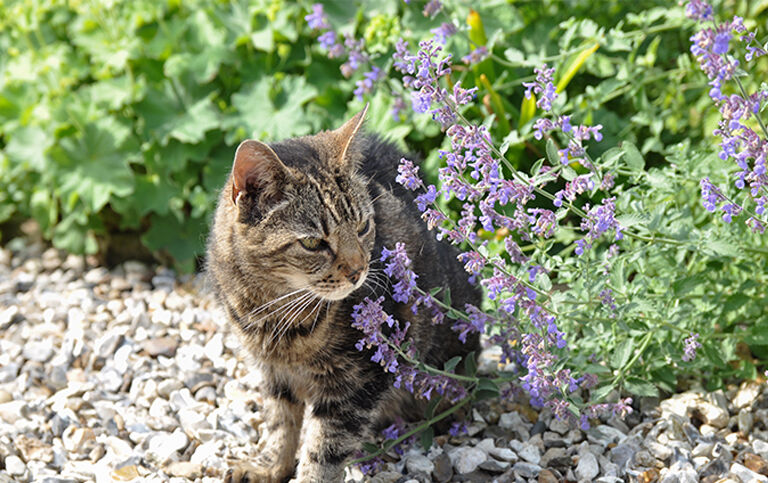What is catnip or catmint?
Catnip, also known as catmint, cat wort or field balm, is a plant that’s native to Europe. It’s a member of the mint family, with a citrusy scent with the scientific name of neptea cataria. Technicalities apart, if you see your cat heading for one of these plants don’t be surprised if he gets very excited in a matter of seconds.
The effects catnip has on your cat
Catnip contains a chemical compound called nepetalactone, one of the volatile oils found in the plant.
According to the magazine the Scientific American, this affects 70-80% of cats; the effects last for around 10 minutes, and then your cat won’t respond to it again for the next 30 minutes.
The exact effects vary, but there’s one thing they have in common: making your cat happy. Once he feels attracted to the scent of catnip, your cat will sniff at it, rub himself against it and might even want to eat it.
Cats under the influence of catnip are euphoric, very playful and hyperactive.
You’ll see how your cat will start rolling around head-over-tail in it: he’ll be extremely playful and might even hunt imaginary animals. Although the effects aren’t the same for every cat.
The benefits of catnip
Catnip can be beneficial for your cat in several ways:
Anti-stress
At those times when you cat’s feeling stressed, for example after moving house, or after a tense situation at home. Playing with catnip for a while can help him to feel more relaxed for the rest of the day. Furthermore, his behaviour might be calmer thanks to the stress relief provided by the catnip.
For exercise
If your cat’s lazy, and one of those who don’t like moving around too much, maybe a scratcher or a cat tree with a bit of catnip can push him into being more active. Furthermore, your cat will associate the fun he’s had with the toy, which means he’ll have more reason to use it more often.
Contraindications of catnip
Some call it the ‘drug for cats’, but nothing could be further from the truth: the plant is not harmful to your cat’s health. That said, you do need to control the dosage and your cat’s environment when you give it to her.
It’s best to ask you vet for advice on the correct dosage for your particular cat. In terms of environment, it’s important to watch out for things in your house that could prove dangerous, such as places your cat could be in danger of falling, or where there are fragile objects he could knock over. Bear in mind that your cat might get so excited that he won’t be able to control himself as he normally would.
On rare occasions catnip can cause vomiting or an adverse reaction. In all probability this means your cat has an allergy to the plant.
Where can you buy catnip, and how should you give it to your cat?
You can find catnip in the wild, as it grows in many places: on wasteland, embankments, hedges, amongst the ruins of old houses… You can also go to a specialised shop: there you can buy the seeds and then grow it at home.
In these shops it’s very likely that they sell dried catnip, in the form of tablets, a spray or drops. You’ll also find cat accessories that contain some of this substance, such as scratchers, toys, chew sticks… And there are treats that contain catnip too.
If you’re still feeling unsure, you could try it out to see what effect catnip has on your cat, and whether or not it produces a reaction. However, do be very aware of the precautions you need to take to make the environment safe for your cat.
 Copy link
Copy link
 Publish on Facebook
Publish on Facebook
 Publish on Twitter
Publish on Twitter
 Publish on WhatsApp
Publish on WhatsApp
